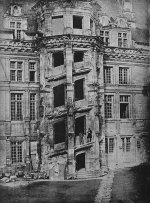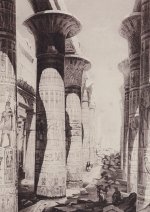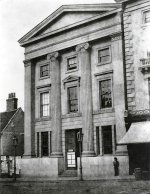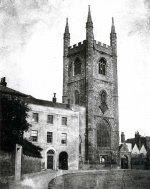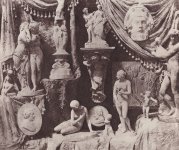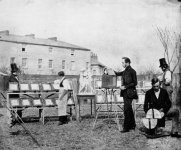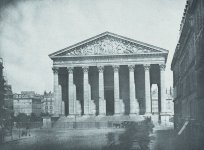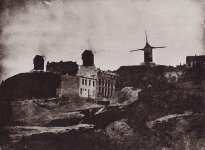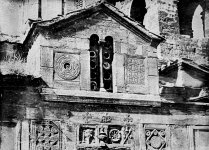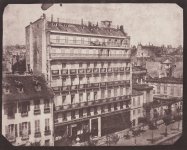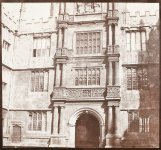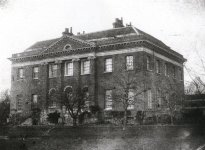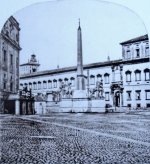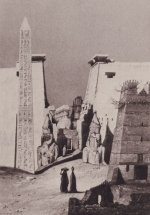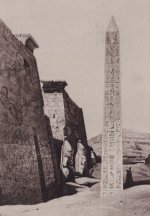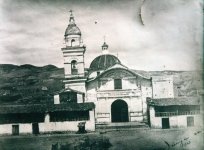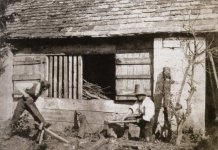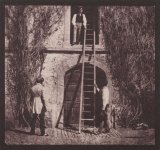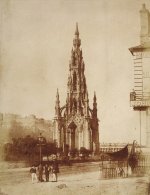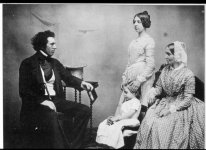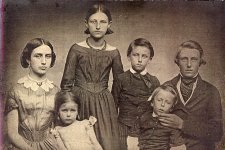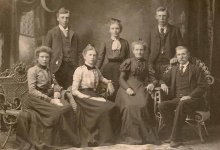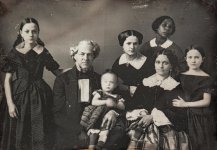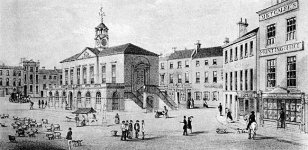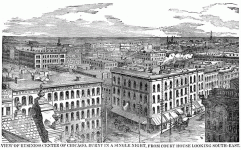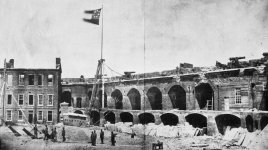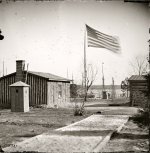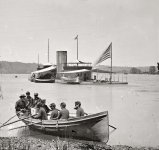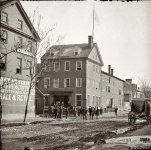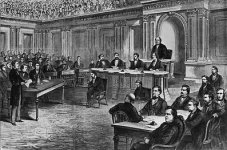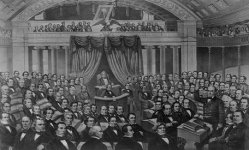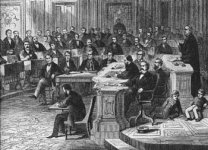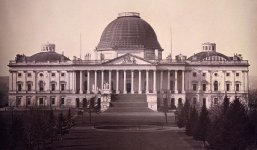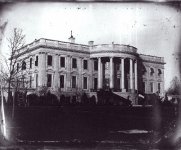I wanted to share an observation of mine. Primarily because it provides for a possibility of one very peculiar historical development. It I will sound as unrealistic as it gets.
I will present a hypothesis that there was no United States of America prior to the Civil War time frame. This hypothesis could be, and most likely is wrong, for we have tons of historical documents (Declaration of Independence, etc.) which suggest otherwise. Yet, we do have two hard to explain facts, which, at the very least, should persuade the reader to ask a few questions, and do some research on his/her own.
The first permanent photoetching was an image produced in 1822 by the French inventor Nicéphore Niépce, but it was destroyed in a later attempt to make prints from it. Niépce was successful again in 1825. In 1826 or 1827, he made the View from the Window at Le Gras, the earliest surviving photograph from nature.
Niépce's camera photographs required an extremely long exposure - at least eight hours. Niépce died in 1833 and Daguerre then redirected the experiments toward the light-sensitive silver halides, which Niépce had abandoned many years earlier because of his inability to make the images he captured with them light-fast and permanent. Daguerre's efforts culminated in what would later be named the daguerreotype process.
The required exposure time was measured in minutes instead of hours. Daguerre took the earliest confirmed photograph of a person in 1838 while capturing a view of a Paris street: unlike the other pedestrian and horse-drawn traffic on the busy boulevard, which appears deserted, one man having his boots polished stood sufficiently still throughout the several-minutes-long exposure to be visible. The existence of Daguerre's process was publicly announced in 1839.
British chemist John Herschel made many contributions to the new field. He invented the cyanotype process, later familiar as the "blueprint". He was the first to use the terms "photography", "negative" and "positive". He had discovered in 1819 that sodium thiosulphate was a solvent of silver halides, and in 1839 he informed Talbot (and, indirectly, Daguerre) that it could be used to "fix" silver-halide-based photographs and make them completely light-fast. He made the first glass negative in late 1839.

Daguerreotype
Very early daguerreotypes (those from 1839-1845) did take 60-90 seconds of sitting still to capture an image, but the majority of daguerreotypes we see today are from post-1845, when new technology (the addition of bromine fumes to the process) reduced exposure times to a few seconds.
1830s-40s photo sources:
Armed with the above information, let us try to find some 1840-1860 photographs of the most prominent cities in the United States of America. The links below will take you to google image search results I linked to the 1840's dates. You are welcome to replace 1840 with 1850. The results are not going to change much.
We will look for:
Note: if in the search results you see a photograph, do not assume that it is from 1840s, or 1850s. Most likely it is going to be a much later years, which is not relevant for the purposes of this article.

Obviously, as the number of member states grew, the flag was getting updated with additional stars. We will go up to 33 stars. The 34 star flag would get us into the 1860s.

Flag Source: USFlag.org: A website dedicated to the Flag of the United States of America
Obviously, we had an introduction of the Confederate Flag group in the 1860s. But it is taking us into the Civil War area, and this is an entirely different topic. Though there will be a little Civil War touch up below.
Are those US flags? They sure look like US flags. Dates of the photographs are supposed to be between 1861 and 1865, but who is to say that we are not experiencing another reenactment conducted at a later date? Even these were located after an extensive search.

flameto (TY)
In general, even as late as the actual Civil War, we do not see any reasonable number of the United States of America, or Confederate flags in the photographs.
Once again, the Civil War is the cornerstone event of future developments in my opinion. Please do not base your replies to this article topic on the Civil War materials alone.
KD: We have clear proof that photography was widely available, within the constraints of its time of course. Yet, with the abundance of 1840s family photographs, we are missing some very important photographic proof pertaining to the 1840s - 1859 time frame (and could be even later).
Photographs, which appear to be missing:
Eventually everything comes down to one simple question: where are the US photographs off the cities and the
KD summary: I believe the Congress of the United States could afford a photo or two, to preserve the legacy via the first photographed sessions. Same goes for the major cities.
What about any sort of the flag display by the United States government? Not even the Capitol Building, or the White House?
I do not believe for a second that there were no city photographs, government in session or flag photographs for that matter. The question is why the actual photos were substituted with paintings and sketches. Could it be that photographs contained something we were not supposed to see? I don't know, may be something like a differently looking flag, or some technology which supposedly did not "exist".



District of Columbia Organic Act happens in 1871.
East India Company seizes to exist in 1874.
1600-1874

Could it be that there were no United States of America prior to the Civil War?
I will present a hypothesis that there was no United States of America prior to the Civil War time frame. This hypothesis could be, and most likely is wrong, for we have tons of historical documents (Declaration of Independence, etc.) which suggest otherwise. Yet, we do have two hard to explain facts, which, at the very least, should persuade the reader to ask a few questions, and do some research on his/her own.
The first permanent photoetching was an image produced in 1822 by the French inventor Nicéphore Niépce, but it was destroyed in a later attempt to make prints from it. Niépce was successful again in 1825. In 1826 or 1827, he made the View from the Window at Le Gras, the earliest surviving photograph from nature.
Niépce's camera photographs required an extremely long exposure - at least eight hours. Niépce died in 1833 and Daguerre then redirected the experiments toward the light-sensitive silver halides, which Niépce had abandoned many years earlier because of his inability to make the images he captured with them light-fast and permanent. Daguerre's efforts culminated in what would later be named the daguerreotype process.
The required exposure time was measured in minutes instead of hours. Daguerre took the earliest confirmed photograph of a person in 1838 while capturing a view of a Paris street: unlike the other pedestrian and horse-drawn traffic on the busy boulevard, which appears deserted, one man having his boots polished stood sufficiently still throughout the several-minutes-long exposure to be visible. The existence of Daguerre's process was publicly announced in 1839.
British chemist John Herschel made many contributions to the new field. He invented the cyanotype process, later familiar as the "blueprint". He was the first to use the terms "photography", "negative" and "positive". He had discovered in 1819 that sodium thiosulphate was a solvent of silver halides, and in 1839 he informed Talbot (and, indirectly, Daguerre) that it could be used to "fix" silver-halide-based photographs and make them completely light-fast. He made the first glass negative in late 1839.
Daguerreotype
Very early daguerreotypes (those from 1839-1845) did take 60-90 seconds of sitting still to capture an image, but the majority of daguerreotypes we see today are from post-1845, when new technology (the addition of bromine fumes to the process) reduced exposure times to a few seconds.
In the March 1851 issue of The Chemist, Frederick Scott Archer published his wet plate collodion process. It became the most widely used photographic medium until the gelatin dry plate, introduced in the 1870s, eventually replaced it.
Some Photo Sources:- Photography - Wikipedia
- Nicéphore Niépce - Wikipedia
- View from the Window at Le Gras - Wikipedia
- Daguerreotype - Wikipedia
- The First Picture Of People - From 1838
- Daguerreotype Q&A
- 1840s Photos Are Brought To Life With Color - Resource
1830s-40s photo sources:
- Amazing photographs of elderly New Yorkers in the 1840s | Daily Mail Online
- Category:1837 photographs
- Category:1839 photographs
- Category:1840 photographs
- Category:1841 photographs
- Category:1842 photographs
- Category:1843 photographs
- Category:1844 photographs
- Category:1845 photographs
- Category:1846 photographs
- Category:1847 photographs
- Category:1848 photographs
1850s Family Photographs
1850s yield hundreds of family pictures. Which means that photography is becoming more affordable and widespread.Armed with the above information, let us try to find some 1840-1860 photographs of the most prominent cities in the United States of America. The links below will take you to google image search results I linked to the 1840's dates. You are welcome to replace 1840 with 1850. The results are not going to change much.
We will look for:
- New York 1840s
- Boston 1840s
- Chicago 1840s
- New Orleans 1840s
- Plymouth 1840s
- San Antonio 1840s
- Charleston 1840s
Note: if in the search results you see a photograph, do not assume that it is from 1840s, or 1850s. Most likely it is going to be a much later years, which is not relevant for the purposes of this article.
US Flags
1777-1860
1777-1860
First Official US Flag

This 13-Star Flag became the Official United States Flag on June14th, 1777 and is the result of the congressional action that took place on that date. Much evidence exists pointing to Congressman Francis Hopkinson as the person responsible for its design. The only President to serve under this flag was George Washington (1789-1797). This Flag was to last for a period of 18 years.
Obviously, as the number of member states grew, the flag was getting updated with additional stars. We will go up to 33 stars. The 34 star flag would get us into the 1860s.
Flag Source: USFlag.org: A website dedicated to the Flag of the United States of America
Obviously, we had an introduction of the Confederate Flag group in the 1860s. But it is taking us into the Civil War area, and this is an entirely different topic. Though there will be a little Civil War touch up below.
The Civil War
1861-1865
I do not really want to use the Civil War as any sort reference point here. There are too many reenactment photographs, and shady characters involved there. My personal opinion on the Civil war is not quite formed yet. One thing I do believe, it was not what we are lead to believe it was.1861-1865
Are those US flags? They sure look like US flags. Dates of the photographs are supposed to be between 1861 and 1865, but who is to say that we are not experiencing another reenactment conducted at a later date? Even these were located after an extensive search.
flameto (TY)
Once again, the Civil War is the cornerstone event of future developments in my opinion. Please do not base your replies to this article topic on the Civil War materials alone.
KD: We have clear proof that photography was widely available, within the constraints of its time of course. Yet, with the abundance of 1840s family photographs, we are missing some very important photographic proof pertaining to the 1840s - 1859 time frame (and could be even later).
Photographs, which appear to be missing:
- any photos of the US flag in the urban environment
- any reasonable number of the major city photographs
- any US Congress photographs
Eventually everything comes down to one simple question: where are the US photographs off the cities and the
KD summary: I believe the Congress of the United States could afford a photo or two, to preserve the legacy via the first photographed sessions. Same goes for the major cities.
What about any sort of the flag display by the United States government? Not even the Capitol Building, or the White House?
I do not believe for a second that there were no city photographs, government in session or flag photographs for that matter. The question is why the actual photos were substituted with paintings and sketches. Could it be that photographs contained something we were not supposed to see? I don't know, may be something like a differently looking flag, or some technology which supposedly did not "exist".
By 1803, at the height of its rule in India, the British East India company had a private army of about 260,000 - twice the size of the British Army.
US Army 1st General Order, “I will guard everything within the limits of my post and quit my post only when properly relieved.”
District of Columbia Organic Act happens in 1871.
East India Company seizes to exist in 1874.
Grand Union Flag
American Flag under British control

Grand Union Flag
Flag of the East India Company
The flag between 1668 and 1801

Flag of the East India Company
East India Company: Granted a Royal Charter by Queen Elizabeth in 1600, it became one of the most powerful mercantile organizations in the world by maintaining a monopoly on the importation of exotic goods (notably cotton, tea, and silk) from India into Britain. It also maintained a standing military, which was used in many cases to consolidate and enforce local authority in Indian territories.American Flag under British control
Grand Union Flag
Flag of the East India Company
The flag between 1668 and 1801
Flag of the East India Company
1600-1874
Could it be that there were no United States of America prior to the Civil War?


